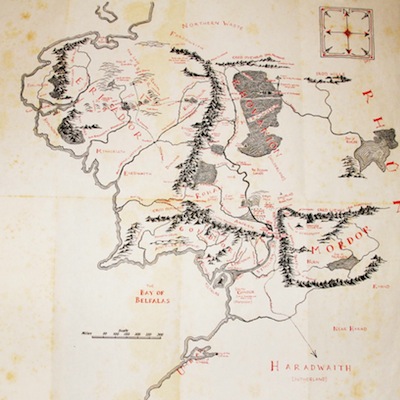The 5 Best Fantasy Maps Ever Drawn

Writers and Nigerian princes trying to move millions of dollars out of their country know one absolute truth: If you present people with enough documentation, they will suspend their disbelief. That’s why so many epic fantasy stories come with detailed, hand-drawn maps. The first 20 or 30 books I ever read all had maps in the front matter, so by the time I was ready to try my hand at writing my own books, the first thing I did was draw a map of my imaginary world.
There is nothing more soothing than drawing all those little triangles for mountains, my friends.
Not all maps are created equal. A good map has to evoke the feeling of a mysterious new world while simultaneously grounding you in the action. Below, find five of the best examples of fantasy maps: delightful to look at, really useful as you read, and, as an additional bonus, watershed examples of the technique of using tiny triangles to represent mountain ranges.
The Lord of the Rings, by J.R.R. Tolkien
Let’s start at the beginning, then, with the granddaddy of all epic fantasy: Tolkien’s The Lord of the Rings. The sheer number of maps available, their incredible detail, and the way they allow the reader to always know where in relation to everyone (and everything) the action is taking place make these the maps to beat—which is, of course, why every fantasy map since then has been a slavish copy.
Mountain Triangle Quality: The highest grade. These tiny triangles have shading and depth. These tiny triangles are so good, Led Zeppelin wrote a song about them.
A Song of Ice and Fire, by George R.R. Martin
When a TV show uses your map in order to clue in a bewildered audience, you know you’re at the top of the map-making game. A Song of Ice and Fire’s map has been elevated to multimedia art installation by the producers of HBO’s Game of Thrones, to the point where people hear the theme music every time they crack open the books.
Mountain Triangle Quality: Pretty Good. There’s a suspiciously similar quality to the mountain triangles, which implies that someone got lazy and used cut-and-paste on a whole bunch of them. There’s shading, too, but it’s a bit more perfunctory than in Tolkien’s maps.
Lord Foul’s Bane, by Stephen R. Donaldson
Stephen R. Donaldson’s The Chronicles of Thomas Covenant gets remembered for a lot of things: for having a leper as a protagonist, for featuring an assault scene in Lord Foul’s Bane that made this reader’s 11-year-old hair stand up, for introducing the world to the word Hellfire! as an all-purpose exclamation. But the maps are very well done, too, although they make the common mistake of simply trailing off at the edges because the author grew weary of coming up with names for his made-up locations.
Mountain Triangle Quality: Mediocre. They’re not particularly triangular in places, and are sometimes difficult to tell apart from the tiny triangles that represent trees.
The Belgariad, by David Eddings
As it’s one of the most detailed fantasy epics ever written, filled with memorable characters and a deep backstory and mythology that few series can rival, you’d expect some nifty maps, and Eddings’ books don’t disappoint. The unnamed setting is presented in a series of very detailed maps, starting with a general world map, then individual maps for new setting across two linked continents, making the characters’ travels easy to follow.
Mountain Triangle Quality: Poor, actually, as the decision to try and imply foothills often results in mountain ranges that resemble cooked spaghetti, which any fantasy fan will tell you is entirely inappropriate. Also, if you turn the map upside down, the mountains resemble attacking birds, which may cause nightmares.
The Eye of the World, by Robert Jordan
The Wheel of Time may be the longest and most complex of all modern epic fantasies, but at first glance, the map that accompanies the books is a bit…lackluster. Over time, however, the small details provided, including the the innovative idea of actually showing the official borders between the distinct realms, prove their worth.
Mountain Triangle Quality: Excellent. The mountains are more like pyramids, giving the topography a bit of depth and spark, although the curiously geometric arrangement along the eastern and northern edges betrays the fact that the mountains, as in many fantasy novels, exist solely to explain why no one ever tries to go in those directions.
What’s your favorite fictional map?